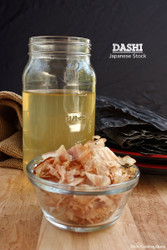Katsuobushi (Dried Bonito Flakes)
Posted by Kristen McBride on Jan 11th 2022
When you think Japanese food, what is the first thing that comes to mind?
Sushi. That seems to be the general answer.
No, I’m not saying that’s what everyone thinks of, but it seems to be the first answer- followed closely by hibachi and maybe, for the well-read, bento or gyoza. However, there is soooo much more to Japanese food.
Japanese food is a balance of precision and patience with the sporadic beauty of seasonal ingredients and delicate, often unique flavor combinations. Japanese cuisine is built within the roots of the culture itself and is based on five tenants, each with five reflections, according to A Travelling Foodie in Japan. These come from the recognition of the five elements represented in Japanese Buddhism. Let’s explore them!
1.Five Flavors
The most commonly known tenant of Japanese cooking is the five flavors- salty, bitter, sweet, sour and ‘umami’ or savory. Balance between these flavors within each dish, from something as simple as sashimi to the complexity of kaiseki, is paramount to developing a compete dish.
2.Five Senses
We have all heard that we “eat with our eyes” and know that there is more to a good meal than just how it tastes, but in Japanese cuisine all five senses are strived to be pleasingly stimulated. Does it smell appetizing? Is the flavor balanced? Does it has a good mouth-feel? Can you hear the still sizzling meat or the crunch of the tempura? Does it delight you to look at it all set out- even the tableware?
3.Five Colors
Since the 6th century when Buddhism began in Japan, the five colors of white, black, red, green and yellow have been used not only in religious architecture and artwork but also in food. We see, even in western food culture, that having more color on your plate makes it look healthier and more appetizing. Japanese cuisine has used this to make any complete meal be a feast for the eyes.
4.Five Cooking Methods
Japanese cuisine makes use of five different methods of cooking which include raw, simmered, steamed, grilled, and fried. In a complete meal, all will be represented, lending to satisfying all the senses and drawing the experience of the meal out.
5.Five Reflections
The five attitudes of Japanese cuisine originate in ‘shojin ryori’, the strict vegetarian diet of the monks who follow Zen Buddhism, a style of teaching that has been around for 800 years. It compounds the point of fresh foods, the care put into a meal, the satisfaction of enjoying it, and what we should do with ourselves and the energy we have gained.
- We should be thankful to the whole process of growing, gathering and cooking food.
- We should be worthy of the food on our table.
- We should be at peace when we eat our meal.
- Our food should nourish our stomachs and also our souls.
- After eating, we should try to achieve enlightenment.
“Now, Kristen, all I wanted to do was eat my sushi and dumplings! Why’d you have to go and make my food so complicated?”
That’s a great question!- but I promise that wasn’t my intention. If I am going to make traditional food, I think it is important to understand where the food comes from and the heritage behind it. Food is tradition you can taste and our most accessible insight into a culture.
That being said, I did make Japanese food sound a little intimidating, didn’t I? Where should we even start!? What even are the basics?
When I think of the very basics of Japanese cuisine, the first building block that comes to mind is Dashi Broth (Awase Dashi). Smoky and sultry, dashi is the umami-loaded base for countless Japanese dishes. There are recipes for dashi all over the internet but what it really comes down to are two power house ingredients—kombu (kelp) and katsuobushi (bonito flakes). In fact, it’s more like making a delicate tea than a stock: You’re looking to extract the flavor of kombu through gentle heating, and then the bonito through steeping.
Don’t let the name intimidate you. Katsuobushi is simply dried Bonito Flakes. And if you are wondering what are dried bonito flakes? they are just dried, smoked, and fermented fish fillets. Bonito flakes themselves can impart the sought after umami flavor and can be glazed, rehydrated with sake, or even tossed in a simple soup on their own.
Umami is an elusive flavor that we often refer to as “savory” but that doesn’t quiet cover the description of earthy depth that leaves behind as full a flavor as it brings. Dashi is considered the quintessential umami- so that’s where I believe we should start. If the “Mother Sauces” of European cuisine are the building block on which flavor is built, then dashi is one of the mother sauces of Japan.
For all of it’s importance, dashi broth is deceivingly simplistic and fast to make. Unlike traditional stock, you don’t need hours to leech flavor from bones and fat. The delicate and healthy ingredients yield their bounty quickly. There is more a risk of OVER cooking them than not garnering enough flavor.
Japanese Dashi Broth
Ingredients:
- 4 Cups water
- 2 x 4 inch of dried kelp (Kombu)
- 3 Tablespoons dried Bonito flakes
Instructions:
- Place the kombu and the water, on high, in a large pot on the stove. When it begins to boil, (just at the small bubble point) remove the kombu from the pot.
- Allow the water to continue to boil, then add the Bonito flakes to the pot.
- After it has come to a full boil, use a strainer to strain the soup into a large serving bowl.
Dashi broth is a delicious Japanese stock base used for miso soup, the most commonly known thing we use it for. However, it can also be served with noodles, or by itself as a stand-alone broth. It can be used to impart flavor to sushi rice, to base dipping sauces, and even used to mix the batter for the popular Takoyaki an Okonoiyaki. It will keep for about a week in the refrigerator. This recipe, using our bonito flakes, is as easy as it is delicious!
Never be afraid to explore, to embrace the tenants of another cuisine, or even tweak it to make it your own. Try something new. After all, our food should nourish our stomachs and also our souls.

